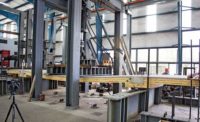The U.S. is lagging Europe, Canada and Australia in the massive-timber tall-building movement—heating up because renewable, low-carbon-footprint timber is the most sustainable structural material. A feasibility study released last week for a 42-story concrete-jointed mass-timber frame—considered supertall in a world in which the tallest timber building is only 105 ft—could begin to change all that by stirring up interest in tall timber structures in the U.S. and even providing grist for the mill for supertall timber towers elsewhere.
Under the Timber Tower Research Project, a team from the Chicago office of architect-engineer Skidmore, Owings & Merrill developed a performance-based conceptual design for a composite structure that is "marketable, serviceable, economical and sustainable," says Benton Johnson, the SOM structural associate who led the seven-month project, funded by the Softwood Lumber Board. SOM is not patenting the structural system.
In its 72-page report, the firm recommends further research, including fire tests, to verify performance and convince building officials that timber towers are safe. "The biggest obstacles [to tall timber towers] are regulatory," says Johnson.
Building codes restrict wood frames to four or five stories, mostly because wood is combustible. But change is in the air. The National Fire Protection Association (NFPA) has a research project, called Fire Safety Challenges of Tall Wood Buildings, that could lead to prescriptive timber-tower provisions in NFPA's model life-safety and building codes.
"We think sustainable design is great, but we have to make sure it doesn't trump occupant or building safety," says Robert E. Solomon, division manager for building and life-safety codes for the Quincy, Mass.-based NFPA.
The San Francisco office of Arup is performing the first part of the study, which includes a literature review and design guidance, under a $30,000 grant from the Fire Protection Research Foundation. A report is due out in November.
Johnson and others agree there is a misconception about fire safety and mass timber. In a fire, smaller wood members and more massive timber members perform very differently. Timber does better.
With timber, building contents ignite the outer layer of the member. It burns, chars and forms an insulation layer, which suffocates the fire and keeps the member's core cool and structurally sound.
Performance-based design (PBD) can demonstrate whether timber structures can still hold the load after the building contents burn out, says Johnson. For this, a fire protection engineer would need to establish fire loads and design criteria.
Until the codes change, tall timber buildings must gain approval under the code's equivalency or PBD clauses. In each instance, the engineer must convince the building official that building performance would be equivalent to the performance of a code-approved material.






Post a comment to this article
Report Abusive Comment